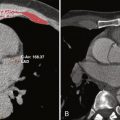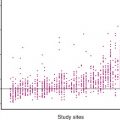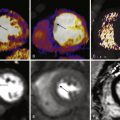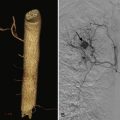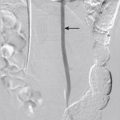Ultrasound is the most popular noninvasive imaging technique for evaluation of the vascular system. Vascular ultrasound has significant advantages. It provides comprehensive anatomic and flow details of the vascular system, particularly the peripheral vessels. It is easily available, is cost effective when compared with the other vascular imaging methods, and involves no ionizing radiation. However, the diagnostic yield is highly dependent on the expertise of the operator. The patient’s body habitus often limits the quality of the examination and visibility of the vessels, especially the intraabdominal vasculature. Certain anatomic and pathologic characteristics of the vessels, such as vessel tortuosity, multifocal tandem atherosclerotic stenosis, and extensive vascular calcifications, pose limitations for the use of vascular ultrasound.
Vascular ultrasound has two basic components: conventional B-mode ultrasonography, which provides morphologic information about the lumen and vessel wall; and Doppler ultrasonography, which displays flow direction and velocity of red blood cells (RBCs).
Physical Principles
Ultrasound is a high-frequency sound (by definition, >20,000 Hz, but medical ultrasound imaging frequencies range from 2 to 15 MHz) produced by piezoelectric effect by the elements within the ultrasound transducer. Modern ultrasound machines are equipped with multielement transducers, with each element having its own circuit. Each transducer is designed to work best at given range of frequencies. The frequency of the transducer depends on the thickness of the piezoelectric element and the voltage applied to the piezoelectric element. The transducers vary by shape (linear or sector), physical functioning principle (mechanical or electronic), and the range of frequencies of the ultrasound beam emitted. The ultrasound frequency determines the depth of penetration and the resolution of the image.
Ultrasound interacts with tissues as it propagates and returns. As an ultrasound wave passes through the tissues, a fraction of it is converted to heat, and a fraction is converted to reflected or scattered ultrasound. The transducer receives and converts the reflected or scattered ultrasound from tissues into electric signals that can then be amplified, analyzed, and displayed to provide both an anatomic image and flow information. Each ultrasound image is made up of image lines. Each image line is formed by hundreds of grayscale pixels based on the information in the reflected and scattered waves from the tissues. Strong reflectors are depicted by white pixels, and weak reflectors are represented as dark shades of gray. Thus, in B-mode imaging, the vessel wall, which is a strong reflector, appears bright, whereas intravascular blood flow is anechoic because the RBCs are very small and have a very low backscattering coefficient.
Doppler ultrasonography is based on the principle of the Doppler effect. When a wave is reflected from a moving target, the frequency of the perceived wave is different from that of the transmitted wave. This difference in frequency is known as the Doppler shift. The magnitude of the shift depends on the relative motion between the source and the receiver of the sound. The frequency of the perceived wave increases when the source moves toward the receiver, whereas it decreases when the source moves away from the receiver ( Fig. 6-1 ). The direction of the Doppler shift depends on whether the motion is toward or away from the receiver.

In vascular imaging, the Doppler signal is generated by the blood cells that backscatter the transmitted ultrasound wave. Because of relatively low numbers of white blood cells and small size of platelets, the RBCs are generally assumed to be responsible for scattering of ultrasound by blood. Individual RBCs act as point scatterers because their mean diameter is much smaller than the wavelength of the ultrasound.
The Doppler equation is formulated as follows ( Fig. 6-2 ):


Where f D is the Doppler shift frequency f is the frequency of the transmitted ultrasound wave, v is the relative velocity of the moving target with respect to the transducer, and c is the speed of sound in the tissue (on average, 1540 m/second); is the angle of the direction of the moving target with respect to the transducer. This angle is 0 degrees when the target is moving head-on toward the transducer, and it is 90 degrees when the target is moving parallel to the transducer surface. Factor 2 represents two equal successive Doppler shifts that simply are added together. The first Doppler shift occurs when sound is received by the moving RBCs from the stationary transmitting transducer, and the second occurs when sound is received by the stationary transducer from the RBCs that now act as a moving source as they reradiate sound back toward the transducer.
The Doppler signal is proportional to frequency shift ( f D ). According to the equation, the Doppler frequency shift is directly proportional to the transmitted ultrasound frequency. Thus, higher-frequency transducers are preferred for Doppler studies. Because the rate of attenuation of the ultrasound beam is directly proportional to the transmitted frequency, higher-frequency ultrasound transducers have poor signal from deeper tissues because of high beam attenuation. Conversely, lower-frequency ultrasound transducers have better signal from deeper tissues. Scatterers smaller than the ultrasound wavelength are not good reflectors. For example, RBCs have poor scatter intensity at lower ultrasound frequencies (the wavelength is inversely proportional to the frequency). According to the Rayleigh theory of wave scattering, the scattered intensity increases with the fourth power of the ratio of scatterer (RBC) size to wavelength. For higher ultrasound frequencies with shorter wavelengths, the scattering from RBCs increases. Thus, 8-MHz ultrasound gives the strongest signal from the carotid arteries 2 cm deep under the fat and muscle in the neck; 3.5-MHz ultrasound has good penetration and gives the strongest echo from the renal arteries 10 cm deep under the muscle and fat in the abdomen.
The Doppler signal also depends on the angle between the direction of motion and the axis of the ultrasound beam. The Doppler shift is maximum and so is Doppler signal when the blood flow is parallel ( cos is equal to 1) to the ultrasound beam and is zero when the blood flow is at right angles ( cos 90 is equal to 0) to the ultrasound beam. In clinical practice, the ultrasound beam is aligned to make a 30- to 60-degree angle with the arterial lumen to obtain a reliable Doppler signal. Other important factors that affect Doppler signal are the velocity and number of the blood cells in the sample volume.
The two main types of Doppler ultrasound equipment in clinical use today are continuous wave Doppler and pulsed wave Doppler. In continuous wave Doppler, the probe contains two piezoelectric crystals, one to transmit the ultrasound wave continuously and the other to receive from the sensitive region of the beam (which is at the intersection of the transmitted and returning beams) continuously. The equipment usually operates at one continuous frequency. Continuous wave Doppler simultaneously analyzes many returning signals from multiple vessels in the line of the beam and thus has no range or depth information. It does not provide directional information about the flow, nor does it have axial resolution. The operator must distinguish veins and arteries by flow characteristics alone because the images provide only qualitative information (magnitude of Doppler shift). Continuous wave Doppler is resistant to aliasing and is more sensitive to slow flow than is pulsed wave Doppler. In current practice, continuous wave Doppler is used in cardiac examinations and in pressure studies for evaluating the peripheral arteries.
Newer ultrasound devices use the pulsed wave Doppler ultrasound technique. As the name suggests, the pulsed wave Doppler ultrasound probe transmits short bursts of ultrasound at regular intervals and receives them as they return. This system measures the phase shift in the received signal by using the mathematical process of autocorrelation. It obtains phase shift information by sampling the same sample volume multiple times and analyzing the echoes. The information obtained by measuring the phase shift is almost the same as that obtained by measuring the frequency shift, with certain limitations. In contrast to continuous wave Doppler systems, pulsed wave Doppler ultrasound provides information about the velocity and direction of flow. In addition, pulsed wave Doppler allows precise control over range in tissue (depth) and sample volume. The range in tissue at which Doppler signals are detected can be controlled simply by changing the length of time the system waits after sending a pulse before it changes to receiver mode. The location of the sample volume within the area of interest is guided by real-time B-mode imaging. This combination of real-time B-mode imaging and pulsed Doppler technique is known as duplex scanning. Color Doppler and spectral Doppler devices use pulsed wave Doppler techniques to process information that can provide flow characteristics such as velocity and direction.
Color Doppler translates Doppler phase shift information containing velocity details from an area of interest into color-coded images. Two basic colors are used to specify the direction of flow in the area of interest, and this color display is usually superimposed on the conventional B-mode image. Typically, blue represents positive flow, which is toward the heart, whereas copper represents negative flow, which is away from the heart. The depth and width of the Doppler interrogation in the area of interest are usually defined by the user and are known as the color window. This technique is particularly useful for identifying the location of abnormal velocity and for mapping the extent of flow in anatomic regions for stenosis, aneurysm, or turbulence.
Spectral Doppler is another form of pulsed wave Doppler that analyzes Doppler frequency shift information from a specific area within a vessel and displays it as a function of time. The focal area interrogated by spectral Doppler is known as the range gate (sample volume). The spectrum of velocities of blood cells within the range gate is displayed in a waveform on a two-dimensional display with time on the x-axis and frequency on the y-axis. Depending on the direction of flow, spectrum is deflected on either side of the x-axis (baseline). In clinical practise, positive Doppler frequency shifts (blood moving toward the probe) are displayed above the baseline, and negative Doppler shifts (blood moving away from the probe) are displayed below the baseline. The amplitude of each velocity component is depicted as grayscale brightness of the spectral waveform. It takes approximately 64 to 128 pulses per scan line to calculate the spectral Doppler shift. The maximum possible pulse repetition frequency (PRF) and maximum recordable Doppler shift depend on the depth of the range gate. The new ultrasound pulse should not be emitted before all information from the previous pulse is received, for optimal quantification of Doppler shifts. Thus, PRF should be at least twice the maximum velocity (or Doppler shift frequency) of blood within a vessel to display actual measurements without ambiguity. The Nyquist limit is the maximum Doppler shift frequency that can be measured without aliasing, usually less than PRF / 2. The spectral Doppler technique is used to quantify flow velocities and to identify abnormal blood flow.
The Doppler shift frequency may also be represented as an audible sound. It is qualitative: a higher pitch of the sound usually indicates a larger Doppler shift (or higher velocities). In addition, this frequency is independent of the direction of blood flow.
Power Doppler ultrasound is another Doppler technique that measures the amplitude of the Doppler frequency shift independent of the Doppler angle. The magnitude of the Doppler frequency shift is usually displayed with one color of varying brightness by the autocorrelation technique. Power Doppler ultrasound displays neither flow direction nor flow velocities. Because of its better signal-to-noise ratio, power Doppler is sensitive to slow flow velocities in small vessels.
B-flow imaging is a newer vascular imaging method that images blood vessels in B-mode without application of the Doppler principle. This technique measures the amplitude of scatterers in flowing blood to construct a grayscale image with shades of gray. B-flow imaging depicts the vessel lumen, plaque characteristics, and broad spectrum of velocities better than does color Doppler because of a higher frame rate and better special resolution. Nonapplication of the Doppler principle means that B-flow imaging is resistant to artifacts such as aliasing and overamplification of the signal. Because B-flow imaging is a B-mode technique, estimation of blood flow velocities and determination of flow direction are not possible.
Ultrasound contrast imaging uses microbubble contrast media to image blood vessels. The injected intravascular microbubbles act as nonlinear reflectors or scatterers of the ultrasound beam and can be imaged using B-mode and Doppler techniques.
Pearls and Pitfalls
- ▪
For spectral Doppler imaging, high PRF settings are used when high flow velocities are suspected. The PRF depends on the depth of the range gate: the closer the range gate to the transducer, the higher the maximum PRF that can be used; the shorter the depth of the range gate, the higher the maximum PRF that can be used.
- ▪
Color Doppler imaging provides visual representation of flow direction and areas of increased velocities. Quantification and accurate flow characteristics are best evaluated with spectral Doppler techniques.
- ▪
The most important advantage of power Doppler imaging is improved flow sensitivity because of an increased signal-to-noise ratio and the ability to use a low PRF. The Doppler signal is independent of the angle of insonation. Aliasing is not seen in power Doppler imaging because the amplitude is independent of flow direction. Power Doppler imaging lacks velocity and flow direction information. It is prone to flash artifact secondary to tissue motion, especially in a low-PRF setting.
Problem Solving: Image Optimization
Optimal image acquisition in vascular ultrasound depends on two main factors: ultrasound technique and instrumentation. Ultrasound technique largely relies on the individual sonographer’s skill and experience. Adoption of good technique and a standard imaging protocol with sound knowledge of anatomy and vascular hemodynamics can yield better images. A good practice is to image blood vessels in the B-mode, to visualize normal anatomy and pathologic features, before color Doppler is performed for qualitative assessment of blood flow and flow abnormalities. Finally, spectral Doppler imaging is used to assess vascular flow quantitatively. Most modern ultrasound Doppler equipment is configured to image various specific anatomic regions with predetermined scan parameters. However, proper instrument selection and knowledge of the scanning parameters as detailed here are crucial for optimal vascular ultrasound imaging.
- 1.
Transducer frequency determines the depth of view and the strength of the Doppler signal.
- 2.
Gain is the amplitude of the received signals over the total length of the ultrasound beam. B-mode gain increases the overall brightness of the image and helps display contrast among various tissues. The color and spectral Doppler gain determines the sensitivity to detect flow in a given sample volume.
- 3.
Time gain compensation (TGC) allows step-up or step-down amplification of sound from various depths to compensate for the effect of attenuation.
- 4.
The focal zone is the point of greatest intensity at which the width of the ultrasound beam is at its narrowest and has best lateral resolution.
- 5.
High-pass filter removes unwanted frequencies (generated from vessel wall and adjacent soft tissue motion) below a set frequency limit.
- 6.
The baseline is the center of the spectral Doppler display, and it corresponds to a zero Doppler shift or zero velocity. The baseline and velocity scale should be adjusted in such a way that the entire spectrum of waveform is visible in a single frame.
- 7.
The angle of insonation is the angle at which the ultrasound beam intersects the blood flow. The Doppler frequency increases as the ultrasound beam becomes more aligned to the flow direction.
- 8.
Sample volume is the site in which the ultrasound beam interrogates the blood cells in the area of interest. In color Doppler technique, the size, shape, and location of the sample volume determine where the color display of the Doppler frequency shift will occur. Sample volume in spectral Doppler imaging determines the segment of vessels to be sampled for spectral analysis.
- 9.
PRF determines the rate at which the transducer generates the ultrasound pulse. In clinical practise, low PRF is used to detect low velocities, and high PRF is used for detection of high velocity. In addition, the deeper the sample volume is in the tissue, the lower the PRF should be to detect slow flow.
Pearls: General Scanning Technique
- ▪
Select the appropriate probe frequency and footprint based on the anatomic region.
- ▪
Always start scanning blood vessels in the B-mode first and then follow with color and spectral Doppler imaging.
- ▪
Select an acoustic window where the target vessels are in the most superficial plane and are visible through soft tissues of uniform density, such as muscle.
- ▪
Position the focal zone just deep to the area of interest for better lateral resolution.
- ▪
In B-mode, try to examine the vessel in a plane perpendicular to the vascular lumen for better visualization of the vessel wall, plaques, or thrombus.
- ▪
Optimize the gain setting in such a way that no noise is seen within the lumen on B-mode imaging, filling of color is uniform within the lumen on color Doppler imaging, and no noise is noted in the spectral display.
- ▪
Keep the sample volume (color box) small to the area of interest in color Doppler imaging to achieve a higher frame rate.
- ▪
Steer the sample volume or “heel and toe” the transducer to insonate the vessel of interest at an angle of up to 60 degrees.
- ▪
Use a high-frequency transducer to increase the Doppler shift if low-velocity flow is suspected.
- ▪
In spectral Doppler imaging, set the wall filter at the minimum level to detect low velocities and set it at a high level to omit wall motion artifact.
Doppler Artifacts
Artifacts result from inadequate transducer and image acquisition settings, anatomic factors, and hemodynamic changes. Various Doppler artifacts are listed in Table 6-1 .


